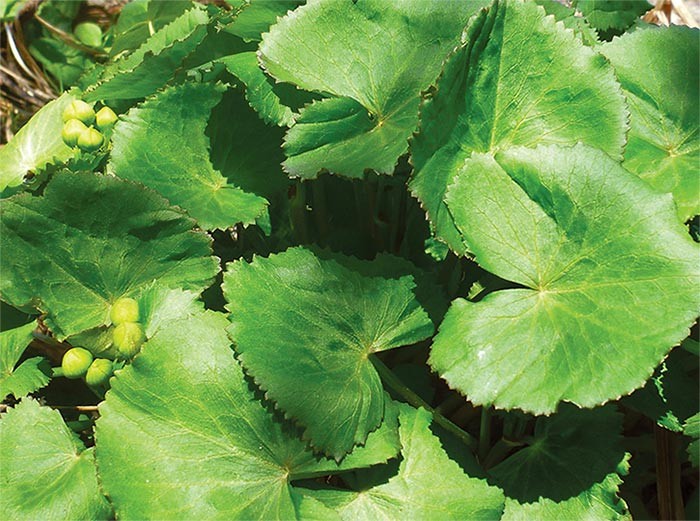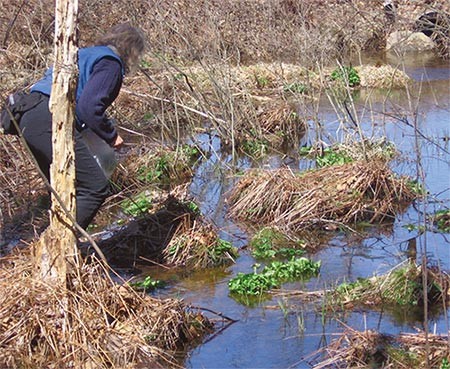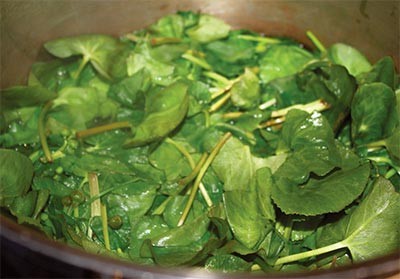
The marsh-marigold (Caltha palustris) (also known as cowslip and kingcup) is not a marigold at all; it is a member of the buttercup family (Ranunculaceae) that grows in shaded marshes, ditches, and streams around the northern hemisphere. The flavor of marsh-marigold greens receives mixed reviews. Some foragers only pursue them because they are available early in the spring when few other greens are. However, I have found that the marsh-marigold has much to recommend.
In mid to late spring, the marsh-marigold’s yellow flowers resemble those of other buttercup family members, but they’re considerably larger. Unfortunately, the greens are best gathered in early spring when the flowers are still wrapped tight in their round, button-like buds. At harvest time, identification relies upon leaves, stems, and buds alone, so we’ll need to be familiar with all the features of the plant, not just the ones that are easy to find in a field guide.
Foot-high clusters of heart- or kidney-shaped leaves show up as splashes of green against the browns and greys of the springtime marsh. Closer inspection (which often requires a pair of waterproof boots) reveals shallow teeth on the leaf margins. While ascertaining a positive identification, it is wise to note nearby plants, as well. The marsh-marigold can share its habitat with several fatally toxic species (water and poison hemlock, for example), no part of which should inadvertently make its way into the forager’s gathering bags.
In addition to mud boots, also bring gloves. Like other buttercup family members, marsh-marigolds produce protoanemonin, a carbohydrate-based toxin that can irritate the skin. Because of it, marsh-marigolds should never be eaten raw. An attempt to do so would likely be short-lived, anyhow, as the uncooked greens taste terrible. With gloves, however, the tender leaves can be safely pinched off. The stems are hollow, succulent, and satisfying to pick. Gather a large volume as they cook down dramatically.
When wild food guides recommend that a green be prepared with a long boiling in multiple waters, I am often skeptical. Guides are often overly cautious about cooking recommendations for wild plants. But with marsh-marigolds, I follow these recommendations and boil the greens for 30 minutes in three changes of water. This significantly reduces their bitterness.
Despite the ambivalence of other wild food authors for marshmarigold greens, I rather like them. They have a texture that reminds me of spinach and a mildly bitter flavor when well cooked. Like other bitter potherbs, I prefer to prepare them in oils and serve them with something starchy like rice, as in the recipe given here.
The marsh-marigold serves as a great example of how learning to forage requires a mixture of diligent research and personal experimentation – we’re grateful for the lore passed down from foragers who have gone before, but willing to trust our own experience.
Marsh-marigold Sauté
Submerge marsh-marigold greens in a small pot of boiling water. Every 10 minutes, strain the greens, discard the water, add new water, and begin boiling anew. Have a large pot of water boiling nearby to refresh the small one.
In a sauté pan, heat 2 tablespoons olive oil over medium heat. Add half an onion, diced. Cook until soft. Add 1 teaspoon chopped ginger, 1 clove minced garlic, ¼ teaspoon cumin, a dash of cayenne, and salt to taste. Cook two more minutes. When the greens have boiled for 30 minutes in three changes of water, toss them in the oil and spices.
Serve the fried greens over warm rice.



